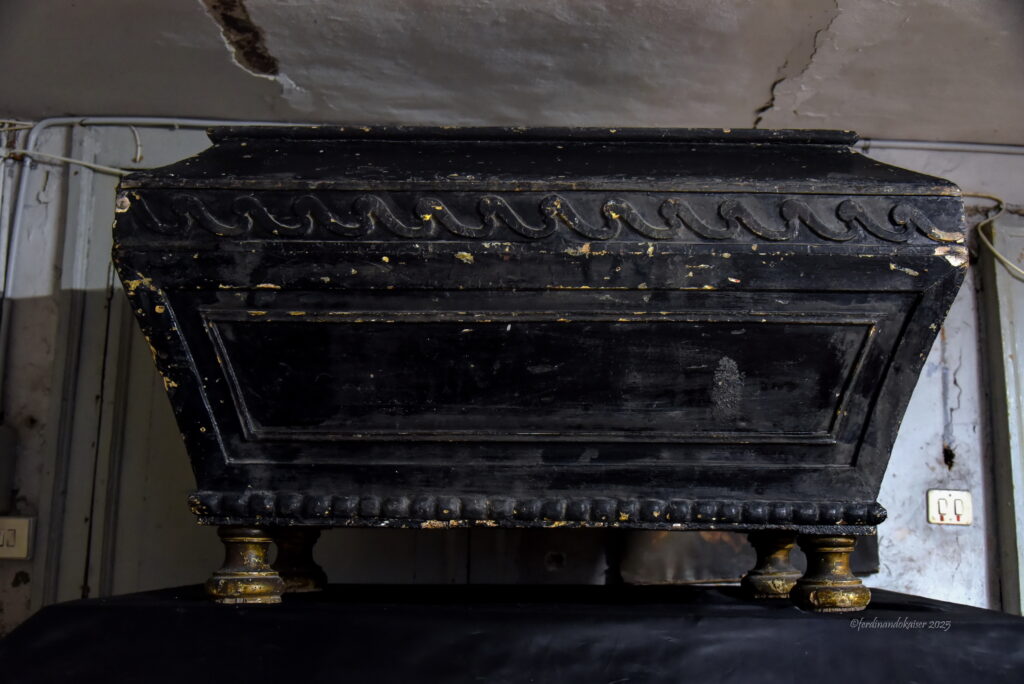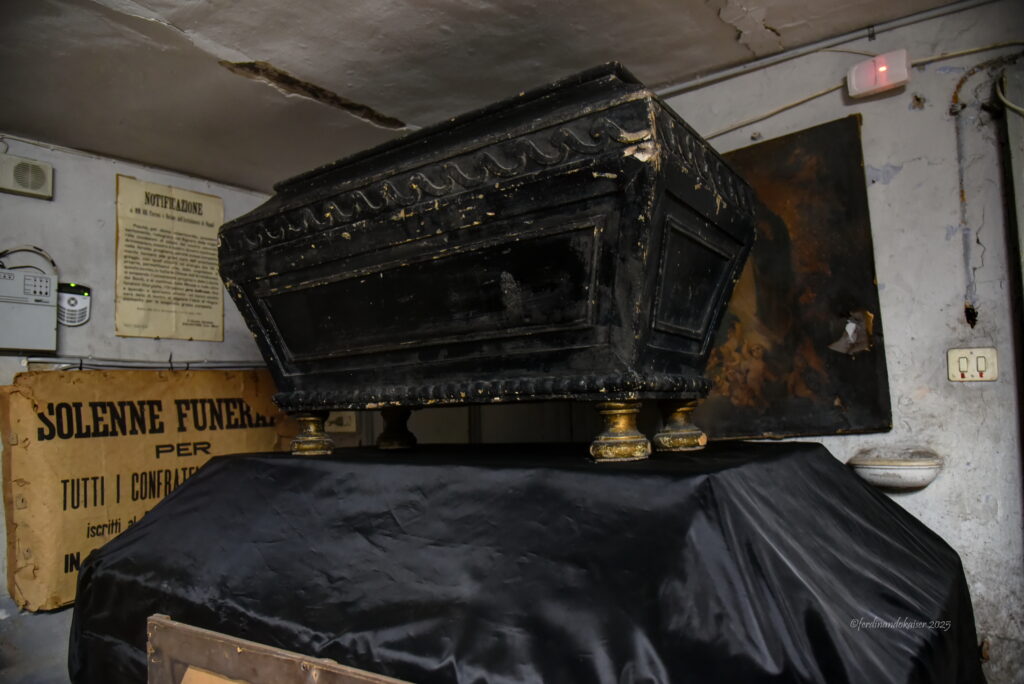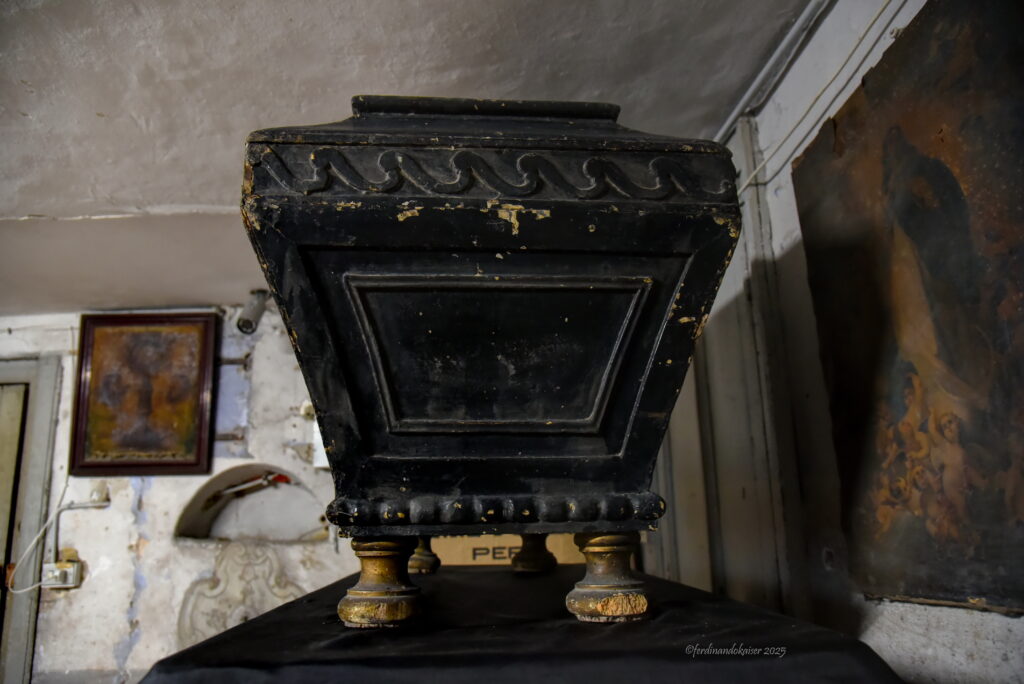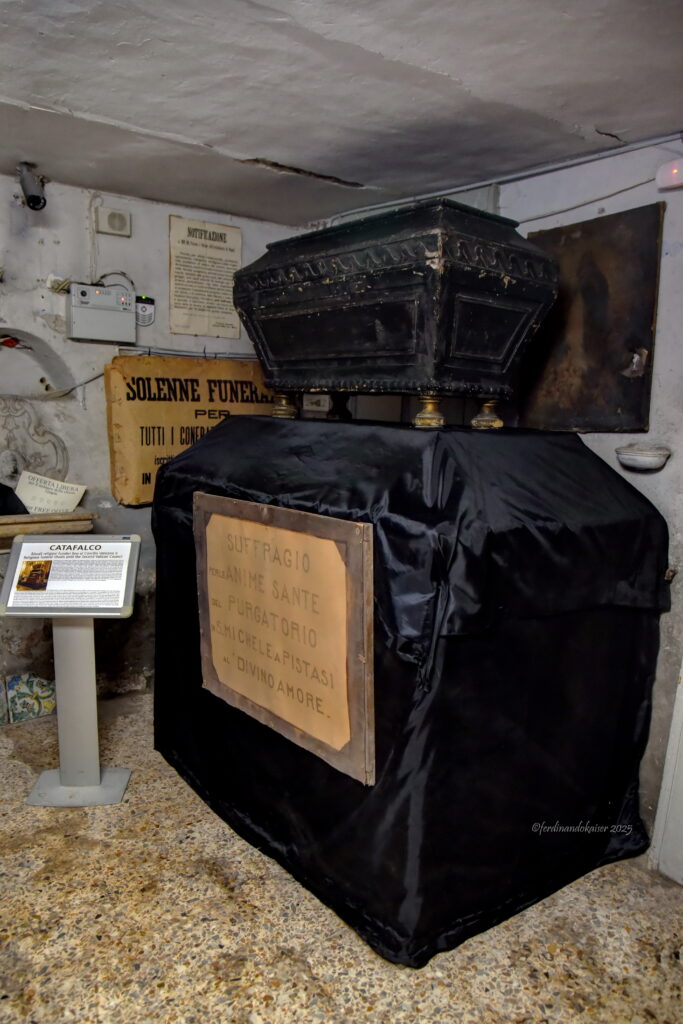Il “Messale San Pio V” (detto anche “Tridentino”) in vigore dal 1570 per “conformare” la Sacra Messa secondo gli usi della Curia Romana, nella commemorazione dei fedeli defunti e durante le celebrazioni funebri, prevedeva l’assoluzione al tumulo eretto sopra un “CATAFALCO”. L’etimologia del termine è alquanto incerta; gli esperti propendono che derivi dal latino “captare” (catturare lo sguardo) e “palco” (luogo elevato e visibile). In sostanza, il catafalco era una “macchina” in legno con una base a tronco di piramide, rivestita di tessuto nero damascato, con ricamo a rilievo di teschi con tibie incrociate e clessidre alate, simboli per i cristiani dell’inesorabile trascorrere del tempo, della dissoluzione del corpo dopo la morte. Questa base poi, era sormontata da una bara, ovviamente senza salma. Quello che doveva colpire il fedele, era la “verticalità” che aveva il compito di dare il senso di ascesa al cielo del defunto. Questo addobbo funerario veniva allestito principalmente durante l’Ottavario dei Defunti dal 2 al 9 novembre o in occasioni particolari come la morte di un Pontefice o del Patriarca, oppure nei “trigesimi”, ossia dopo trenta giorni dalla morte, come nel caso delle Arciconfraternite, del confratello defunto; in queste ultime occasioni, oltre all’allestimento all’interno della chiesa, veniva affisso all’esterno un cartello con il nome del defunto per il quale si celebrava il suffragio. Con la Riforma Liturgica a seguito del Concilio Vaticano II (1962-1965), tutte queste forma di “esteriorità scenografiche” sono state sostituite da una Liturgia più “sobria” e più consona alla celebrazione stessa. Infatti, il 2 Novembre, l’ottava dei defunti e negli anniversari funebri, non c’è più traccia, nelle chiese, dell’imponente catafalco, tutto viene sostituito dal semplice “cero pasquale”, simbolo di Cristo Risorto. Il “catafalco” nulla toglieva alla verità della Resurrezione, aggiungendo, anzi, un’altra verità che è quella del Suffragio come necessario per la liberazione delle Anime del Purgatorio.
The “Missale San Pio V” (also called “Tridentine”) in force since 1570 to “conform” the Holy Mass according to the uses of the Roman Curia, in the commemoration of the faithful departed and during funeral celebrations, provided for absolution at the tomb erected on a “CATAFALCO”. The etymology of the term is somewhat uncertain; experts tend to believe that it derives from the Latin “captare” (to capture the gaze) and “palco” (elevated and visible place). In essence, the catafalque was a wooden “machine” with a truncated pyramid base, covered in black damask fabric, with relief embroidery of skulls with crossed tibias and winged hourglasses, symbols for Christians of the inexorable passing of time, of the dissolution of the body after death. This base was then surmounted by a coffin, obviously without a corpse. What was supposed to strike the faithful was the “verticality” that had the task of giving the sense of the deceased’s ascension to heaven. This funerary decoration was set up mainly during the Octave of the Dead from 2 to 9 November or on special occasions such as the death of a Pontiff or Patriarch, or in the “trigesimi”, that is, thirty days after the death, as in the case of the Archconfraternities, of the deceased brother; on these last occasions, in addition to the set up inside the church, a sign was posted outside with the name of the deceased for whom the suffrage was being celebrated. With the Liturgical Reform following the Second Vatican Council (1962-1965), all these forms of “scenographic exteriority” were replaced by a more “sober” Liturgy, more in keeping with the celebration itself. In fact, on November 2nd, the octave of the dead and on funeral anniversaries, there is no longer any trace, in the churches, of the imposing catafalque, everything is replaced by the simple “Easter candle”, symbol of the Risen Christ. The “catafalque” took nothing away from the truth of the Resurrection, adding, on the contrary, another truth which is that of Suffrage as necessary for the liberation of the Souls of Purgatory.




